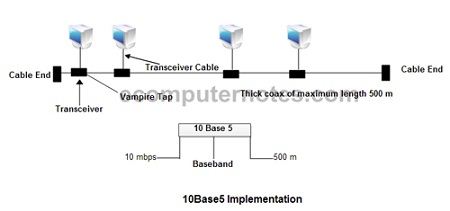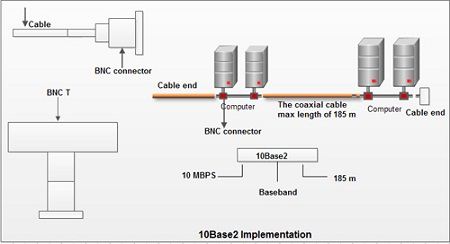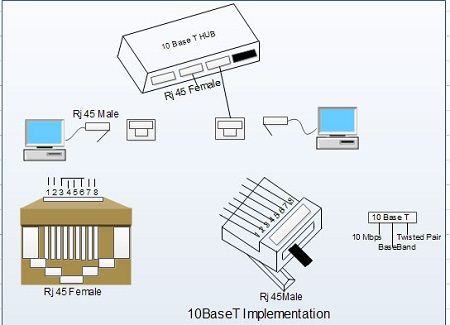Generally, some people use the term “Ethernet” or ether refers to cable. Ethernet was the original product designed by Xerox PARC based on Bob Metcalfe’s idea. It was later upgraded to 10 Mbps by Xerox, Intel and DEC.
This formed the basis for the IEEE 802.3 standard, which then became an ISO standard. Actually, the Ethernet was the implementation of standard 802.3 between the computers of Hawaiian Islands.
Cabling for 802.3: The term Ethernet refers to a network of cables. Various types of cables are being used in different 802.3 implementations.
The following four cable types are the most common among them: 
1. 10Base5 cable. 10Base5 cable or “Thick Ethernet” or Thicknet is the cable which is the oldest in the category. it is called as thicknet because of the use of thick coaxial cable. The cable is marked after each 2.5 meters. The thicknet uses bus topology. These marks are provided for attaching tap points. The connections to this cable are made by “Vampire Taps”. In this type of connection, a pin is carefully forced half a way into the coaxial cable core. The cable operates at 10Mbps and it can support a maximum segment length of 500 meters. It supports 100 nodes per segment. 10Base5 cable allows, at maximum, five segments (each of max of 500 meter) to be connected. These segment are connected with the help of repeaters. Therefore four repeaters are allowed to be used providing the effective length of2.5 km.

It make use of transceiver (transmitter/receiver) connected via a vampire tap. The transceiver is responsible for transmitting, receiving and detecting collisions. This transceiver is connected to the station via a transceiver cable that provides separate path for sending and receiving.
2. 10Base2 Cable. 10Base2 cable also called “Thin Ethernet” or Thinnet or cheapnet or cheapernet, was designed after the thick Ethernet cable. This type of cable is usually thin, flexible and bends easily. It also make use of bus topology. It is also a coaxial cable that is having a smaller diameter than the 10Base5 cable. The connections to this cable are made by BNC connectors or UTP connectors. The connections are created by forming T junctions. These are easier to use and more reliable than vampire connections. The Ethernet based on this type of cables is cheaper and easy to install but it can run for 200 meters and it supports 30 nodes per segment. In both of these network cables, detecting cable breaks, bad taps or loose connections can be a major problem. Here, a special technique, called “Time Domain Reflectometry” is used to detect such kind of errors.

3. 10BaseT Cable. l0BaseT cable or “Twisted Pair” Cable is cheapest and easiest to maintain. This type of cabling is most popular among local area networks. It make use of unshielded twisted pair and provides maximum segment length of 100 m. It make use of start topology. In this type of network, every station is having a wired link to a central device, called “Hub”. Telephone company twisted pair cable of category 5 is used in this type of network. This is an older and known technology of connections. It can support 1024 nodes per cable segment. The maximum length of a segment from hub to station can be 150 meters. This type of networks involves the extra cost of hubs.  4. 10BaseF Cable. 10BaseF cable or “Fiber Optics Cable” is the most efficient and fastest cable in the category of cables for 802 LANs. The fiber optic cable is very expensive as compared to above discussed cables but it offers a very high data transmission speed and noise immunity. This type of cabling is preferred for running networks between buildings or widely separated hubs. It has the highest length per cable segment i.e. 2000 meters and it can support 1024 nodes per cable segment.
4. 10BaseF Cable. 10BaseF cable or “Fiber Optics Cable” is the most efficient and fastest cable in the category of cables for 802 LANs. The fiber optic cable is very expensive as compared to above discussed cables but it offers a very high data transmission speed and noise immunity. This type of cabling is preferred for running networks between buildings or widely separated hubs. It has the highest length per cable segment i.e. 2000 meters and it can support 1024 nodes per cable segment.
 Dinesh Thakur holds an B.C.A, MCDBA, MCSD certifications. Dinesh authors the hugely popular
Dinesh Thakur holds an B.C.A, MCDBA, MCSD certifications. Dinesh authors the hugely popular